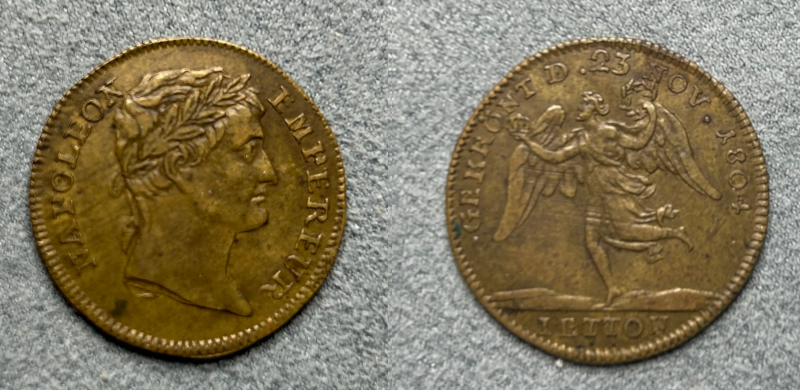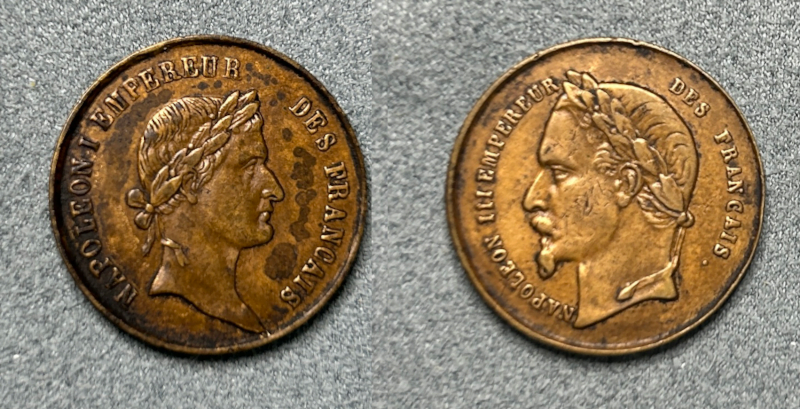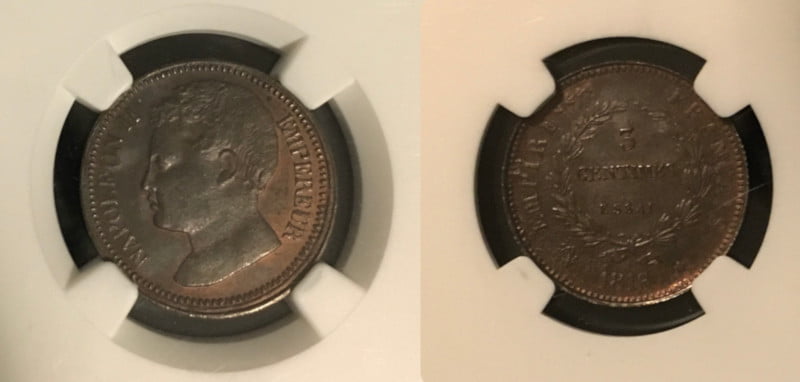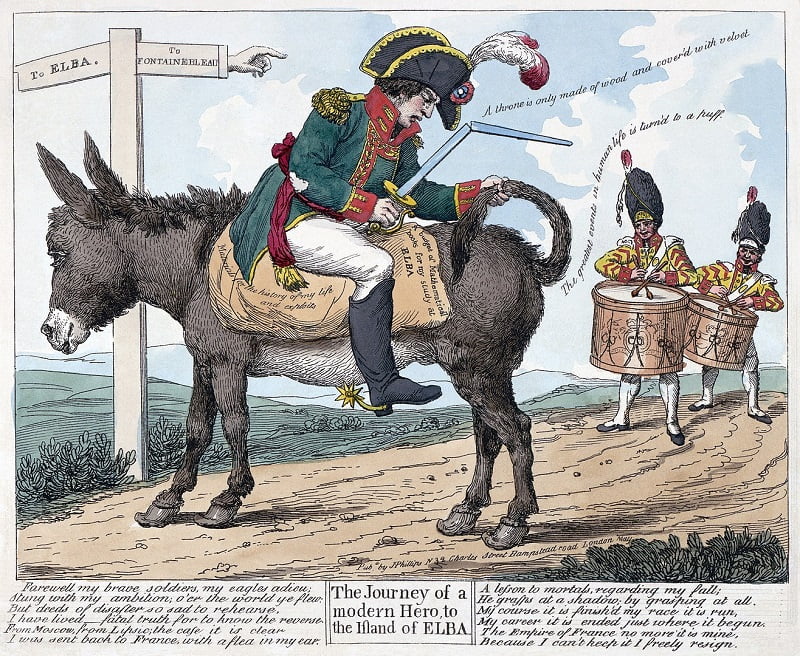Click here for Part I.
As mentioned in the previous post, Napoleon Bonaparte wasn’t shy about putting his bust on coins that would circulate throughout his empire.
Of course those weren’t the only coins he found himself on. Like Andrew Jackson in the United States, Napoleon’s image was used on a variety of unofficial tokens and coins. Some were positive and served to glorify and underscore his dominance. In other cases, they were negative and even celebrated his downfall.
Here are three tokens I recently added to my collection:

In the years leading up to the Napoleonic Era, Germany (like Italy) did not exist as a separate and unified country. Instead, it consisted of hundreds of semi-autonomous city-states that had been held together in the Holy Roman Empire (which, as Voltaire famously noted, was neither holy, nor Roman nor an empire) for centuries. After Napoleon won perhaps his greatest victory at the Battle of Austerlitz in 1805, the Holy Roman Empire was no more and several German city-states fell under France’s sway.
In 1806, Napoleon created the Confederation of the Rhine out of 16 German city-states and placed it under his “protection.” He even installed his brother, Jérôme, as king of Westphalia, which was one of the major kingdoms in the Confederation of the Rhine, while putting his Joachim Murat, his brother-in-law and one of his top generals, in charge of the Grand Duchy of Berg (Murat would be promoted to King of Naples in 1808). Others soon joined and, within a couple of years, the Confederation reached its apex with 36 city-states, including the Kingdom of Bavaria and the free towns of Hamburg and Bremen. However, the largest and most powerful German city-state, Prussia, did not join and would remain a thorn in Napoleon’s side for the rest of his reign.
This token was used in Nuremberg, one of the major cities in Bavaria. Called “jetons,” these coins were commonly used in Europe as gambling chips or gaming tokens. This one commemorates Napoleon’s coronation as Emperor of France. The obverse features Napoleon wearing his customary Caesar-like laurel wreath crown while the reverse features the Greek goddess Nike (who represented victory) holding a laurel wreath in one hand and a crown in the other – the obvious inference being that Napoleon had been ordained by the gods, both as ruler and military warrior. If nothing else, this token served as a not-so-subtle reminder to those in Nuremberg who their boss was.

Of course, not everyone in Europe loved Napoleon. He had plenty of enemies and many of them (including Russia, Austria and Prussia) tried multiple times to bring him down.
But perhaps his greatest enemy was the United Kingdom. Between 1803 to 1815, the British were engaged in a state of near-perpetual war with the French Empire. For his part, Napoleon had considered invading the British Isles but a massive naval defeat at Trafalgar in 1805 at the hands of the far superior Royal Navy put an end to those plans.
Despite their naval superiority, when it came to ground troops, Britain was no match for the Grand Armée, so it relied on building grand coalitions and financing wars against the French Empire. Napoleon defeated several of these coalitions, including the Third Coalition (Britain, Russia, Holy Roman Empire, Austria and others) and the Fourth Coalition (Britain, Prussia, Russia, Sweden and others). However, later campaigns, including the War of the Fifth Coalition (Britain, Austria, Spain, Hungary and others) and the Peninsular War (Spain with help from Britain and Portugal) exacted a heavy toll on France and helped lead to Napoleon’s ultimate downfall.
The British, and most of Napoleon’s enemies, thought that downfall happened in 1814, when the emperor, reeling off back-to-back catastrophic defeats at the hands of Russia and the Sixth Coalition (Britain, Russia, Austria, Prussia, Portugal, Sweden, Spain and several members of the aforementioned Confederation of the Rhine that switched sides late in the campaign), abdicated his throne and was exiled to the island of Elba.
This token commemorates that defeat and exile. Entitled “Inseparable Friends,” the coin, issued in the UK by Thomas Kettle, takes its inspiration from a British political cartoon featuring Napoleon seated backwards on an ass, with a rope around his neck, being dragged by the Devil into exile. The reverse contains the names of the four main foes responsible for defeating Napoleon: The Emperor of Russia, the King of Prussia, the Duke of Wellington (UK) and Prince Schwarzenberg of Austria.
This victory lap pretty much summed up the UK’s attitude towards Napoleon. Long seen as a bloodthirsty tyrant, Napoleon was usually depicted in UK propaganda in harshly negative, even comical terms. In fact, the long-held myth of Napoleon being short came from the Brits (Napoleon was about 5’7” – about average for men of that era). Knowing that Napoleon took great offense to such disrespect only encouraged the British press, which delighted in referring to the emperor as “Little Boney.”
And it worked. Napoleon would later remark that the work of one particular British satirist, James Gillray, “did more than all the armies of Europe to bring me down.”

Of course, Elba wasn’t the end of Napoleon. Less than a year into his initial exile, Napoleon escaped and returned to France, where he ruled for a little over 100 days. Another international coalition then convened to put an end to him once and for all, and Napoleon would suffer his final defeat at Waterloo in 1815 (in Belgium, not San Dimas, CA). His second exile, this time to the remote island of St. Helena, would be a permanent one. Six years after arriving on St. Helena, Napoleon died.
But that wasn’t the end of his bloodline. Prior to going into exile to Elba, Napoleon had abdicated in favor of his three year-old son, Napoleon II. However, the members of the victorious Sixth Coalition refused to allow this and forced Napoleon to abdicate unconditionally. After the Hundred Days, Napoleon tried to abdicate in favor of his son again, but once again, France’s conquerors refused to let that happen.
Even though Napoleon II never officially ruled France, some pattern coins featuring the young child are known to exist.

The next time someone from Napoleon’s family would rule France would be in 1848 when Louis Napoleon, Napoleon I’s nephew, was elected President. Three years later, like his uncle before him, Louis Napoleon seized power in coup and became emperor, taking the name Napoleon III.
Taking another page out of his uncle’s book, Napoleon III tried to buttress his legitimacy by linking himself as closely as possible to his predecessor. For a population that still held Napoleon I in high esteem and longed for a Bonaparte restoration, Napoleon III was able to capitalize on his family connection and consolidate his power.
This token seeks to emphasize that familial and regnal bond between uncle and nephew. The obverse features the classic portrait of Napoleon I used on most francs, complete with laurel wreath crown. On the reverse, Napoleon III’s portrait is a near-mirror image of his uncle – complete with laurel wreath crown.
Of course, the comparisons could only go so far. When it came to his legacy and accomplishments, Napoleon III is held in far lower esteem than his famed uncle.
Rulers imitate rulers because it is politically effective to do so, and Napoleon III was far from original in relying upon illusion, appearances, masks, and reflections to sustain his power It is hard to imagine that anyone at the time believed, or believed that Louis Napoléon believed, that he was the reincarnation of Napoleon I… The fault was, no doubt, in the excess of the ceremonial, not in its inappropriateness, that is in the inappropriateness of its excess, in the expectations that it aroused, in the immense disparity between what the regime pretended to be and what it could achieve.
David Baguley, Napoleon III and His Regime: An Extravaganza.
Unfortunately for him, Napoleon III would have one last thing in common with his uncle. After losing a war to Prussia, he was exiled to England in 1870 and died three years later. Then again, the fact that England had gone from financing wars and producing propaganda against Napoleon to taking in his nephew shows just how much had changed in 60 years. Maybe that’s why I wasn’t able to find a token that commemorated Napoleon III’s defeat. The people who would have done it were now his protectors.

